‘Nowhere to hide’ for investors in market turbulence

Roula Khalaf, Editor of the FT, selects her favourite stories in this weekly newsletter.
Fund managers have been tripped up by global stocks and bonds falling in tandem in the first quarter.
The FTSE All World stocks index, including dividends, dropped 5.1 per cent in the first three months of the year, reflecting rising benchmark interest rates and the outbreak of war in Ukraine.
At the same time, soaring inflation and tighter monetary policy took a 6 per cent bite from the Bloomberg Global Aggregate Bond index, leaving those shying away from stocks without a reliable bolt hole.
The two key markets underpinning global finance are seldom correlated and such moves tend to be rare and brief. This year’s quarterly slump — the worst synchronised decline since both benchmarks have been available — is enduring enough to leave investors questioning how to balance risks in their portfolios.
“The first quarter was challenging,” said Seth Bernstein, chief executive of $779bn US asset manager AllianceBernstein. “There was nowhere to hide for investors.”
For years, a 60/40 balanced approach has been the mainstay of investment portfolios, where investors allocate 60 per cent to equities, for capital appreciation, and 40 per cent to bonds, to potentially offer income and risk mitigation. This worked well over the past decades as equities surged in a near-straight line to record highs and interest rates fell to new lows, firing up bond prices. But this model now faces some serious strain.
“Conventional portfolios are in big trouble,” said Duncan MacInnes, an investment director at £25.3bn wealth manager Ruffer. “Cross-asset correlations are much higher than they were and there is an illusion of diversification across the industry. Everyone is doing worse than they thought they would.”
The classic 60/40 portfolio generated an 11.1 per cent annual return from 2011 to 2021, according to Goldman Sachs Asset Management, or 9.1 per cent a year adjusting for inflation. But fund managers warned that these kinds of returns from a balanced portfolio do not look sustainable over the next decade.
Stocks are near all-time highs, valuations are stretched and US equities are increasingly concentrated in the six biggest technology names — the so-called FAANGM companies: Facebook, Apple, Amazon, Netflix, Google and Microsoft. Meanwhile, bonds are up against the challenges of ultra-low yields, inflation and the prospect of a cycle of rising interest rates.
Michael Hartnett, chief investment strategist at Bank of America, said rising inflation rates meant a third “great bear” market for US bonds was now under way. BofA is warning that long-term bond yields will rise above 4 per cent during 2024 and increases in interest rates by the US Federal Reserve in response to higher inflation are also likely to drag down US stocks. BofA predicts the S&P 500 will fall below 4,000 this year, a drop of more than 15 per cent from its December peak.
The war in Ukraine has heightened these pressures by pushing inflation still higher and compromising the growth outlook.
“From a purely economic point of view, Russia/Ukraine has exacerbated what was already an incredibly difficult position for policymakers,” said Ruffer’s MacInnes. “It has made a very difficult situation worse and exacerbated inflation because it called for more defence stimulus and acted as a brake on commodity supply.”
In this environment, fund managers are advising clients to diversify their investment portfolios — and temper their return expectations.
Vanguard’s LifeStrategy Moderate Growth fund, which allocates 60 per cent of its assets to global equities and 40 per cent to bonds, has delivered a total return, after fees, of 9.1 per cent over the decade to December 2021. Vanguard has now cautioned that returns over the next decade for a 60/40 balanced portfolio are expected to be half that — even before inflation is taken into account.
“A core problem for investors is that 60/40 doesn’t look like it has much return potential,” says Peter Van Dooijeweert, head of multi asset solutions at $148.6bn asset manager Man Group, adding that this builds a case for diversifying in to currencies, commodities and so-called real assets like infrastructure and real estate. However, he cautioned that “it’s easy to say that you need to diversify but it’s not that easy to implement, especially as asset classes like commodities have had monster moves up and no one has forgotten crude was at negative prices only two years ago.”
FT Asset Management newsletter
Our weekly inside story on the movers and shakers behind a multitrillion-dollar industry. Sign up here
Invesco recommends a 50/30/20 portfolio, split between equities, bonds and alternatives. “This is the year that is reminding investors of the importance of diversification,” said Kristina Hooper, chief global market strategist at Invesco. “You can’t exist for the long term on just equities and bonds. And you need to be diversified not just across asset classes but within asset classes.”
As investors get to grips with the fact that the 60/40 strategy that has served them well for decades may now be broken, some are relieved that equities and bonds were only down 5 or so per cent in the first quarter.
“If you look at everything that was thrown at markets in the first quarter, this feels like an OK outcome,” said Man Group’s Van Dooijeweert. “You had a major war, a huge commodities shock, a very hawkish shift in central bank policy, China markets collapsed and then rebounded and the nickel market closed. With all of that noise in the markets I don’t think we’re doing that badly. It could be a whole lot worse.”
Comments